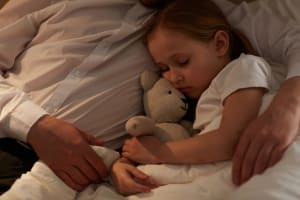
Witnessing a loved one experience night terrors can be a traumatic experience. Characterized by screaming, crying, thrashing, and other reactions to intense fear, night terrors occur as a result of the body and brain being somewhere between asleep and awake.
They can be especially troubling for parents whose young children are the most likely candidates to suffer from this strange disorder. Watching from the sidelines as a child seems to live out a nightmare can make parents feel completely powerless.
But what exactly happens during these episodes? Are they as dangerous as they look? What to do for someone who is having a night terror?
Luckily, sleep researchers know a great deal about the science of these events and have developed a list of management techniques that can keep the disorder in check.
A type of parasomnia
Night terrors, sometimes called sleep terrors, fall under a specific category of sleep disorders known as parasomnias. Parasomnias affect people as they are falling asleep, when they are sleeping or when they are waking up (as opposed to insomnia, which prevents people from falling asleep in the first place). This class of sleep disorders causes unwanted and unintentional physical behaviors that can afflict sleepers at various points in the course of a night.
Different parasomnias are associated with disruptions at various points during the sleep cycle. Parasomnias that occur during the rapid eye movement (REM) phase of sleep include:
- Sleep paralysis
- Nightmare disorder
- REM sleep behavior disorder
Parasomnias which occur during the non-rapid eye movement sleep (NREM) phase include:
- Sleepwalking (somnambulism)
- Confusional arousal
- Sleep-related eating disorder
- Night terrors
Night terrors occur most often during the deepest part of the NREM phase, known as N3 or N4 sleep. Though we cycle through this phase of sleep several times throughout the course of a typical night, it’s during the earlier portion of the night that those events are more likely to occur.
Scientists are unsure about the exact mechanisms causing night terrors, though one 2018 paper hypothesized that the disorder may be the result of mismatches between our modern and evolutionary social environment.
Symptoms of night terrors
Night terrors manifest in episodes of erratic, panicked behavior during the night. The length and severity of these episodes can vary. Some claim that episodes typically last between 30 seconds and 5 minutes, though other sources report that they can last between 45 to 90 minutes.
According to the Mayo Clinic, the most common symptoms of night terrors include:
- Frightening screaming or shouting
- Sitting up in bed and appearing frightened
- Staring wide-eyed
- Sweating, breathing heavily, and having a racing pulse, flushed face and dilated pupils
- Kicking and thrashing
- Getting out of bed and running around the house or exhibiting aggressive behavior if blocked or restrained
Driving this behavior is a subjective experience of terror or fear in the sleeper. They are similar to nightmares in this way, though there are key differences.
For one, nightmares typically occur during the REM phase of sleep when the body intentionally paralyzes muscle activity to prevent the acting out of dreams. Also, sleepers in the middle of nightmares can be woken up relatively easily, and will usually be able to recall the scenario they were experiencing.
Not so with night terrors—it is very difficult to wake a person who is experiencing a night terror. They are likely to be very confused or upset if this happens, and will have little to no ability to recall any part of their experience.
It’s more common in children than adults
Night terrors are significantly more prevalent among children than adults. Experts claim that night terrors affect up to 30% of children. Among the adult population, that number is closer to 1 to 2%.
They are most common among children between the ages of 3 and 7 years old. Typically, night terrors dissipate on their own by the age of 10. Almost all children who experience night terrors at a young age stop having episodes by the onset of puberty.
It is unknown why night terrors affect children more than adults, though some interesting theories are emerging from the evolutionary perspective.

How night terrors are managed
Despite the apparent traumatic nature of these episodes, there is no evidence that they have any negative health effects on their own. However, since sleepers will sometimes move about when they’re experiencing a night terror, there is a chance of bodily injury if their immediate environment is not secure.
Children are most at risk of injuring themselves during night terror episodes. The Children’s Hospital of Philadelphia provides the following advice for parents and caregivers whose children suffer from night terrors:
- Try to help your child return to normal sleep. Do not try to wake up your child. Make soothing comments. Hold your child if it seems to help him or her feel better. Shaking or shouting at your child may cause the child to become more upset.
- Protect your child against injury. During a night terror, a child can fall down a stairway, run into a wall, or break a window. Try to gently direct your child back to bed.
- Prepare babysitters for these episodes. Families should explain to people who care for your child what a night terror is and what to do if one happens.
- Try to prevent night terrors. A common trigger can be if your child becomes overly tired. Be sure your child goes to bed at a regular time, and early enough to give him or her adequate sleep. Younger children may need to return to a daily nap routine.
For adults suffering from night terrors, similar steps should be taken to ensure that safety is maintained during an episode. Some doctors might recommend therapy or medication in addition to changes in sleeping habits for adults. Often times, adult night terrors are exacerbated by other sleep conditions such as sleep apnea, restless legs syndrome, or jet lag.